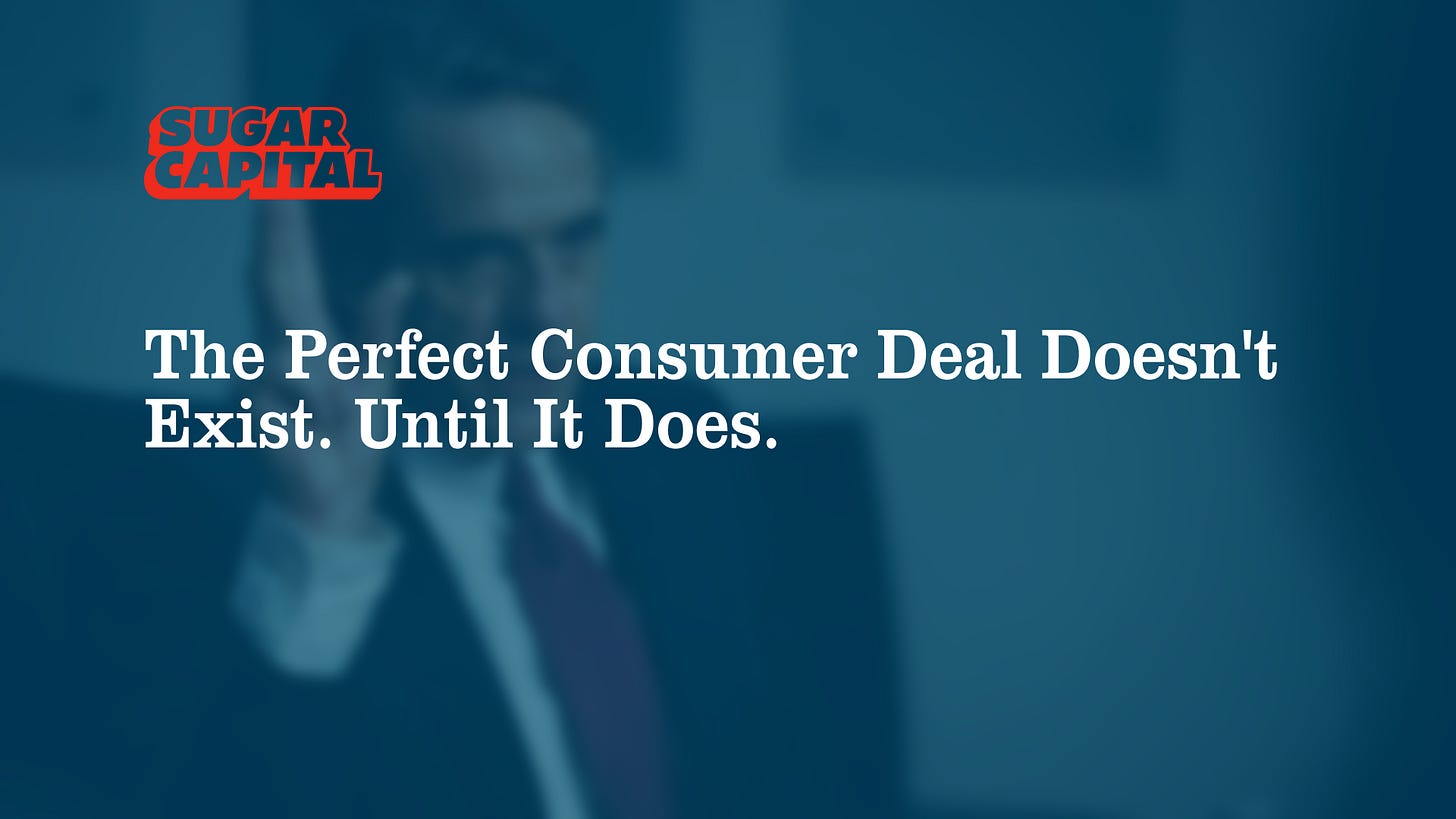The Perfect Consumer Deal Doesn't Exist. Until It Does.
The company that went from zero to $24 million run rate in 180 days.
“There are three ways to make a living in this business: be first, be smarter, or cheat” — John Tuld, Margin Call (2011)
At Sugar Capital, we see hundreds of consumer pitches every quarter. Most founders lead with the same story: they’ve identified a problem, built a solution, and now they need capital to scale. They show us their Shopify dashboards, their Meta ROAS, their wholesale pipeline.
We listen politely. Then we pass.
Good isn’t what we’re hunting. We’re hunting for the convergence of three forces that happen maybe once, twice a year if we’re lucky. Cultural intelligence. Founder-market obsession. And structural economics that make traditional VCs uncomfortable.
Our newest investment has all three.
The Form Factor is the Feature
The company we just backed understands something most wellness brands miss entirely: people already found the perfect form factor. The oral fixation. The moment. The pause. They’re not looking to quit it. They’re looking for it to work for them instead of against them.
The founder didn’t try to fix these people. He didn’t moralize. He simply asked: what if that thing you reach for ten times a day could make you sharper, calmer, more focused?
Think about what Grüns did to gummy bears. They took a form factor people loved but felt guilty about consuming and flipped it on its head. Suddenly eating gummies wasn’t a vice, it was taking your vitamins. People feel like they’re doing themselves a favor by consuming something they already wanted to consume.
This company found something bigger. A behavior spreading like wildfire across millions of users who love the ritual but hate what it represents. The market didn’t need a better version of the old thing. It needed permission to keep doing what it was already doing.
When the Numbers Make You Question Everything
Zero to twenty-four million dollar run rate in 180 days. Online only.
CAC payback in two months.
Gross margins over eighty percent.
Over fifty percent repeat rate in first thirty days.
Most investors see these numbers and assume they’re fabricated. But this is what happens when you stop fighting human nature and start working with it. When you realize millions of people already love the behavior, they just need a version that makes them feel good about themselves.
The founder isn’t a reformed user turned evangelist. He’s not a health optimizer with a savior complex. He’s someone who has founded and scaled consumer companies to millions of users by understanding one thing: human nature. He assembled a founding team that’s equally pragmatic. These are guys who have built and sold D2C businesses from zero to eight and nine figures. Real exits to real buyers.
They understood something fundamental: the best consumer businesses don’t compete in existing categories. They create categories for behaviors that already exist but don’t have a home. The nearest market analog is twelve billion dollars and growing at twenty-eight percent annually. But that’s like measuring Uber against the taxi market. The real opportunity isn’t taking share from competitors. It’s taking a novel consumer behavior that’s spreading like wildfire but that most users have deep-seated fears about and making it something they can be proud of.
Distribution is Destiny
Ninety-six percent of their category’s volume happens in retail. Not online. Retail. Most DTC brands burn millions trying to move convenience store purchases to subscriptions. This team accepted reality instead. They’re using online to prove demand and perfect the machine, but they’re building for where the behavior actually happens. Gas stations. Grocery stores. Behind counters. In checkout lines.
Here’s the twist: they can sell in places their competition can’t. They’re compliant in ways that unlock Whole Foods, CVS, Target. They can sit in the supplement aisle, the energy aisle, at the register. When traditional alternatives are getting banned from pharmacies, this team built something that’s welcome there.
The real genius isn’t the regulatory arbitrage. It’s understanding that every consumer category has a shadow version of itself. The thing people actually want hiding inside the thing they’re allowed to want. This company found one of the biggest shadow categories in America and gave it a name.
Better Anthropology Wins
The consumer brands that win don’t just have better products or better marketing. They have better anthropology. They understand which behaviors are permanent and which are performed. They know the difference between what people say they want and what they actually buy at eleven PM on a Tuesday.
Five years ago, this company couldn’t exist. The behavior wasn’t normalized. The infrastructure wasn’t built. The consumer wasn’t ready to admit what they were really shopping for.
Today? We’re watching them cap growth to avoid stockouts. They’re moving manufacturing to the United States next year. When demand is certain and margins are fat, you optimize for speed, not savings. They’re building five SKUs for five different use cases. Morning productivity. Afternoon focus. Evening calm. Athletic performance. Social confidence.
They’re not selling a substitute. They’re selling an upgrade.
The Sugar Capital Thesis
This is what we look for at Sugar Capital. Not the company that’s incrementally better at someone else’s game. The company that changes what game is being played. Not the brand that captures existing demand more efficiently. The brand that transforms what consumers are willing to admit they want.
The trajectory will feel unprecedented. The category will seem obvious in hindsight, the way all new behaviors do once they’re no longer controversial.
Right now, it’s a founder who understands a simple truth: the best consumer businesses don’t eliminate vice.
They rebrand it as virtue.



And the company isssss :-) a nicotine brand? :-)